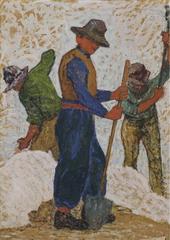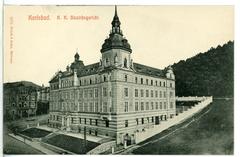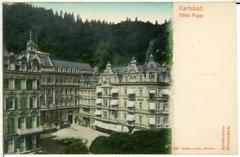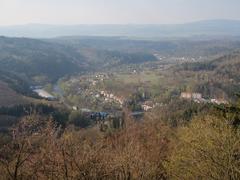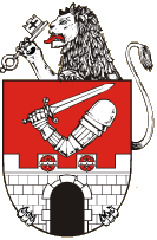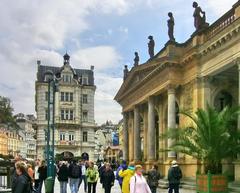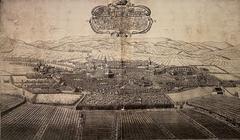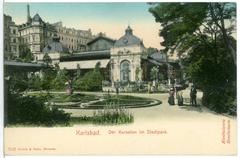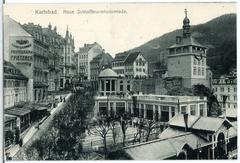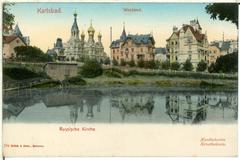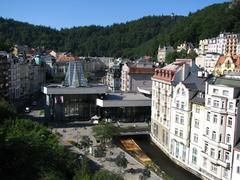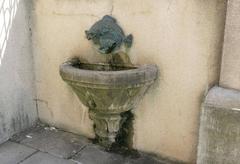
Three Pheasants House Visiting Hours, Tickets, and Historical Site Guide in Karlovy Vary
Date: 04/07/2025
Introduction
Nestled in the heart of the world-famous spa city of Karlovy Vary, Czech Republic, the Three Pheasants House (Dům U Tří Bažantů) stands as a vivid symbol of the town’s rich architectural and cultural legacy. Karlovy Vary, established in the 14th century after Emperor Charles IV discovered its renowned thermal springs, has long been a favored retreat for European nobility and cultural icons, including Goethe and Beethoven. The city’s distinctive blend of Baroque, Renaissance, and Art Nouveau architecture is a testament to its storied past (Karlovy Vary History; Karlovy Vary UNESCO).
The Three Pheasants House, dating to the 19th century, is particularly notable for its ornate facade with symbolic pheasant motifs, reflecting local aristocratic hunting traditions. Located within the pedestrian-friendly historic center, the building contributes to the city’s “living museum” of spa-era architecture (Karlovy Vary Historical Buildings; Adventure Backpack). While the house is a private residence and not open for interior tours, its exterior may be enjoyed year-round at no cost. Many guided walking tours include this landmark as a highlight of Karlovy Vary’s urban and social evolution, spa culture, and heritage tourism (Karlovy Vary Tourist Information).
Ideally situated near key attractions such as the Mill Colonnade, Hot Spring Colonnade, and Grandhotel Pupp, the Three Pheasants House makes for an excellent starting point to explore the city’s historic core. Seasonal events like the International Film Festival further enliven the town, offering visitors diverse opportunities to immerse in contemporary culture (Salt in Our Hair; Explore Globe).
This guide delivers detailed insights into the history, architecture, visitor information, accessibility, nearby attractions, local cuisine, and seasonal events associated with the Three Pheasants House. Whether you are passionate about history, architecture, or simply seeking a memorable travel experience, this guide will help you discover the unique character woven into Karlovy Vary’s heritage.
Table of Contents
- Historical Background: Karlovy Vary and Spa Heritage
- The Three Pheasants House: History and Architectural Features
- Cultural and Symbolic Significance
- Visiting Hours, Tickets & Accessibility
- Guided Tours & Photography Etiquette
- Integrating the House into Your Karlovy Vary Visit
- Nearby Attractions
- Local Gastronomy
- Seasonal Events & Festivals
- Practical Visitor Tips & FAQs
- Conclusion & Further Resources
Historical Background: Karlovy Vary and Spa Heritage
Founded in the 14th century around its healing thermal springs, Karlovy Vary—also known as Karlsbad—quickly rose to prominence as a spa destination for European aristocrats and intellectuals (Karlovy Vary History; Wikipedia). The city’s golden age in the 18th and 19th centuries saw the construction of grand colonnades, opulent hotels, and an eclectic mix of architectural styles. Despite the turbulence of the 20th century, including war and communism, Karlovy Vary has emerged as a UNESCO World Heritage Site, recognized for its historic spa culture (Karlovy Vary UNESCO).
The Three Pheasants House: History and Architectural Features
A product of Karlovy Vary’s 19th-century heyday, the Three Pheasants House is a prime example of the town’s residential architecture (Karlovy Vary Historical Buildings). Its ornate facade, distinguished by three pheasant motifs, exemplifies the Central European tradition of animal-signed houses—a holdover from a time before street numbering.
The building blends Baroque and Art Nouveau elements, featuring decorative stucco, symmetrical windows, wrought-iron balconies, and high ceilings. Though the interior is not publicly accessible, similar period homes in Karlovy Vary are known for grand entrance halls, ornamental staircases, and elegant period details (Adventure Backpack).
Cultural and Symbolic Significance
The Three Pheasants House represents more than architectural mastery—it is a symbol of the town’s aristocratic and hunting heritage (Wikidata). Historically, such buildings provided both residence and guesthouse accommodations for spa visitors, doctors, and socialites. Today, the house is an essential stop on heritage walking tours, where its façade and story enrich the narrative of Karlovy Vary’s past (Karlovy Vary Official Guide).
Visiting Hours, Tickets & Accessibility
- Visiting Hours: The exterior can be viewed year-round, best during daylight (approx. 9:00 AM – 6:00 PM). The interior is not open to the public.
- Tickets: There is no admission fee to admire the building from the street.
- Accessibility: Located in the central pedestrian zone, the area is generally accessible but may have cobblestones. Wheelchair users should inquire at the Karlovy Vary Tourist Information Centre for assistance (Holidify Karlovy Vary).
Guided Tours & Photography Etiquette
While no dedicated tours are focused solely on the Three Pheasants House, many city walking tours include it among their highlights (Karlovy Vary Tourist Information). During the Karlovy Vary International Film Festival and other major events, guided tours often offer expanded commentary on local architecture (Karlovy Vary Film Festival Tips). Visitors are welcome to photograph the façade but should respect residents’ privacy and avoid intrusive behavior.
Integrating the House into Your Karlovy Vary Visit
The Three Pheasants House is conveniently located near key attractions, making it easy to include in a walking tour of the city. Combine a visit with the following highlights:
- Mill Colonnade: Neo-Renaissance colonnade with mineral springs.
- Hot Spring Colonnade (Vřídelní kolonáda): Home to the city’s famous geyser.
- Church of St. Mary Magdalene: Baroque masterpiece.
- Grandhotel Pupp: Iconic spa hotel featured in international films (Explore Globe).
Nearby Attractions
- Diana Observation Tower & Butterfly House: Panoramic city views and a butterfly conservatory (Diana Observation Tower; Butterfly House).
- Castle Tower (Zámecká věž): Historic viewpoint from the city’s medieval castle remains (Amazing Czechia).
- Deer Leap (Jelení skok): Scenic viewpoint with walking trails (Karlovy Vary Activities).
- Jan Becher Museum: Discover the history and taste of Becherovka herbal liqueur.
Local Gastronomy
- Spa Wafers: Sweet, thin biscuits available in traditional and modern flavors (Salt in Our Hair).
- Becherovka: Iconic herbal liqueur (Karlovy Vary Activities).
- Traditional Czech Cuisine: Svíčková, knedlíky, and more at local restaurants like Postal Court and Grandhotel Pupp Café.
- Farmers’ Markets: Sample local cheeses, pastries, and crafts (Karlovy Vary Events Calendar).
Seasonal Events & Festivals
- Karlovy Vary International Film Festival: Held every July, bringing global cinema and festivities (Visit Czechia).
- Dvořák’s Autumn Festival: Classical music events in September–October.
- Opening of the Spa Season: Spring celebrations with parades and concerts.
- Food Festival, Porcelain Festival, Sporting Events, Christmas Markets: A vibrant calendar throughout the year (Karlovy Vary Events Calendar).
Practical Visitor Tips & FAQs
What are the visiting hours?
The exterior is viewable year-round during daylight; the interior is not open to the public.
Is there an entrance fee?
No, viewing the façade is free.
Is the house accessible?
The area is generally accessible, but cobblestones may present challenges. Contact the Tourist Information Centre for specific needs.
Are guided tours available?
Yes, many walking tours include the Three Pheasants House; book in advance during festival seasons.
When is the best time to visit?
Late spring and early autumn offer pleasant weather and fewer crowds. July is lively during the film festival (Best Time To).
What should I keep in mind for photography?
Photography is permitted of the exterior, but avoid disturbing residents and do not use flash indoors if on a special tour.
Conclusion
The Three Pheasants House is a window into Karlovy Vary’s storied past and elegant architectural tradition. Its unique blend of historic styles and symbolic motifs encapsulates the city’s aristocratic and cultural narrative. While interior access is limited, the building serves as an essential waypoint on any exploration of Karlovy Vary’s UNESCO-listed core. Enhance your itinerary with nearby landmarks, sample local gastronomy, and, if your trip coincides, partake in seasonal festivals for a truly immersive Czech spa experience.
For the latest updates on opening hours, tours, and local events, consult the Karlovy Vary Tourist Information Centre or download the Audiala app. Make the most of your visit to one of the most enchanting spa towns in Europe.
References and Further Reading
- Karlovy Vary History
- Karlovy Vary UNESCO
- Karlovy Vary Historical Buildings
- Adventure Backpack
- Salt in Our Hair
- Explore Globe
- Karlovy Vary Tourist Information
- Karlovy Vary Film Festival Tips
- Best Time To
- Diana Observation Tower
- Butterfly House
- Amazing Czechia
- Karlovy Vary Activities
- Visit Czechia
- Karlovy Vary Events Calendar
- Wikidata



